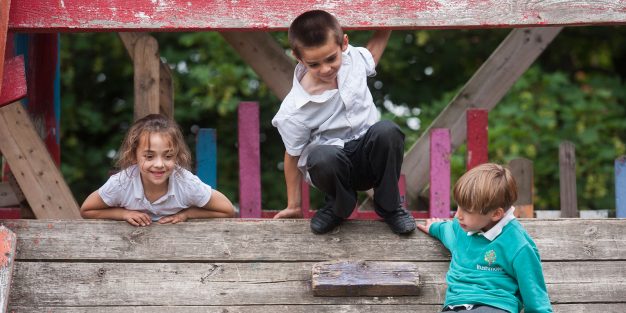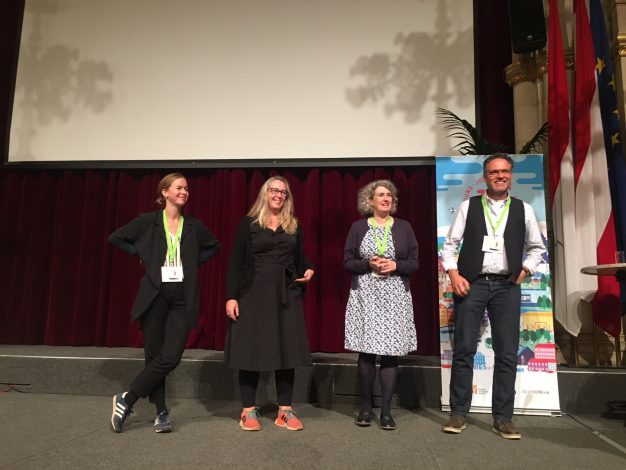
CiTC 2018: Child-friendly planning – parallel session report
How can we ensure child-friendly planning is a reality? It’s a question which gave real food for thought as the first parallel session in the Feestsaal hall at Child in the City World Conference 2018.
A trio of presentations with follow up Q&A sessions focused on several burning issues which are influencing the creation of child-friendly cities, from directly involving children in the process to working with communities.
Kicking things off were Bettina Lamm and Anne Wagner from the University of Copenhagen. Their presentation, ‘Move the neighbourhood’, looked at the co-creation of public spaces with children, the learning aspects and community impact.
They shared some of their practice-based research project which examined what happens when children are involved in the design and building process for outdoor spaces. Their work involved integrating the project into weekly arts and craft classes for children aged 11-13 at Ellebjerg School in Copenhagen.
‘Architectural output’
They explained that the three main aspects involved in this project were: 1) what happens when you build, design and construct urban public spaces with children, what are the actual co-design methods; 2) the ‘architectural output’ that comes out of it and subsequent discussion; 3) the strategic impact of a small-scale project in terms of the development at city and municipality scale.
Bettina said: “Our partners in crime – our co-designers – were 5th grade schoolchildren from a local school in Copenhagen. It’s an age where children are starting to move out their childhood…and are at an age where they kind of lack good places to go in the city, so part of this was exploring with these children and finding what can be relevant for them.
‘Constant conversation’
“We worked together with the school and had about 14 workshops over half a year, lasting about three hours each, and went from designing to implementing a public space.”
In a video featuring interviews with children, the researchers highlighted the concept of the ‘black box’ of co-design, and how children are not ‘vessels of ideas and innovation’. “Children are often quite conservative and will reproduce what they already know, and so in co-design we mean it is a collaboration between designers and children – this helps us develop ideas from the children and this is part of a constant conversation,” said Bettina.
“One of the aspects we mention in the film is going from the ‘I’ to the ‘we’. What we mean with that is that particularly for the individual, for a child to have an experience and get to know the site, to have a feeling with the project and the site, but also as a group, the class, to have a discussion about what is our common project, and on the third scale have a relation to the wider public.”
‘Process and product’
The presentation also highlighted the process and product element, showing how ideas and visions for a particular site turn into actual construction and completion. The message was: ‘No process without product, and no product without process’.
“A very important experience that came out of this for us was that going from the first idea to the finished project was really important, in terms of this idea of ownership and connectivity and that you can have a process without a product but it doesn’t really mean anything. The process and the product were really inter-related in a very important way in this project.”
Bettina and Anne concluded by emphasising three key elements: the co-design methods, which is learning about public space and developing ideas; the architectural outcome, covering innovation in design and aesthetics; and finally the strategic impact, including future prototypes. More information about their work can be found here.
‘Right to play’
The subsequent Q&A exchange with the audience raised issues including the safety of play structures and insurance; the ‘institutional context’ of the project, such as who has responsibility for maintaining new play areas; and the creation of and maintaining dialogue with local neighbourhoods.
The session’s second presentation came from Zeno Steuri, project manager of KinderKraftWerk in Switzerland. He explained how children in Breitenbach, a small municipality in the north west of the country, were involved early in the planning and development of what would be their new school.
He highlighted the following steps in the process: Situation, Exploration, Variants, Consensus and Conclusion. “The whole process was sponsored by a foundation and the municipality, and we were invited to lead the project,” said Zeno. “If you want include children in the design of a new school, you have to do this at a very early stage.”
Exploration workshops
He said that early involvement is vital because by the time architects present their ideas, it is ‘too late’.
“We started with exploration workshops at all grades, looking at the experiences of the children in a school environment, indoor and outdoor. We recorded their experiences on all aspects; lighting, air, colours, infrastructure, furniture and the schoolyard, in structured logs and instant camera pictures – this gave us a picture of everyday life in school.”
Researchers then compared observations made by the teachers of the children with the children’s own feedback. “This allowed us to show the advantages and deficits of the existing infrastructure,” said Zeno.
“Child-friendly cities can be created by taking seriously the children’s ideas about a sustainable and liveable city,” he said. “Breitenbach decided to give all pupils of all school levels the opportunity to contribute their experiences and ideas into the new school building concept before the architectural competition began.
Unique
“This approach is unique in the Swiss school landscape. More than 400 pupils from kindergarten to high school, together with teachers, principals and caretakers, participated in the project. The project developed a guideline for the participation of children and adolescents in school planning.”
Finally, offering a different perspective on the child-friendly planning theme was Nicola Butler, Director of Hackney Play Association in London. Her presentation gave an insight on how the borough of Hackney has continued to support the child’s ‘right to play’ under the shadow of a national austerity drive and local budget cuts.
Hackney is a diverse, densely populated area of east London which, despite having had significant regeneration, also has a high rate of child poverty. Cuts in budgeting both at local and national level, and competition with other social priorities, had combined with wider issues like gang violence, excessive screen time and traffic to create a ‘massively challenging’ environment, said Nicola.
Communities
“This presentation is not about planning, it is actually about how children and communities work together to make the planners want to plan for play,” she said. “Around 25 per cent of the population of Hackney are children and young people, and a very important part of the community which planners often overlook.”
Nicola contrasted the area’s ‘gentrification’ – where areas and housing have rapidly become much more affluent – with social deprivation and poverty. “Austerity is a massive challenge, and one of the biggest challenges is there is no money to maintain playgrounds, so even when a beautiful playground is built, it is not looked after,” she added.
“The biggest challenge is that play has to compete with lots of other social priorities. People often say to me: ‘Nicola, it is all very well going on about play but we need to deal with homelessness, we need to deal with education – why are you going on about play?
‘Children feel happy’
“This is my answer – I talk to children and young people all the time in my work, and it’s one of the joys of my work getting to spend that time with them, and one of the questions I always ask is ‘how do you feel when you are playing? The word that children most often use in response is that they feel ‘happy’ and, really, that’s enough, I do not need to know any more than that. The other word that comes up is safe, and that is huge for children in an area of gang violence. ”
“So, how do we improve play in Hackney? We started at the bottom, we started with one play street – where parents are given permission by the local authority to close the street for a dedicated period and give it over to children’s play activities – and that very quickly grew to 50 play streets.
“We have adventure playgrounds and we also try to work with parks and public spaces. Hackney Play Association works closely with local partners, residents, young people, the municipality – anybody who wants to work with us, it’s what I call ‘coalitions of the willing’. That has resulted in us having many champions for play.”
‘Coalitions of the willing’
This partnership work had, she said, led to positive publicity and political support, culminating in the local Mayor’s wish to create London’s first ‘child-friendly borough’, and the appointment of a councillor for play.
“One result of this is that a clear message has been given to the designers of housing estates – these estates must be more child-friendly The reason they are doing this is because this is a vote-winner – we have a really strong, positive message about children and play, and what we have found is all the departments have come to us, saying they want play to be part of their own policies. We have ended up with the planners coming to us,” concluded Nicola.
She also faced questions on why funding for play projects is a problem in the UK, particularly England; the concept of a play street and how the play association works with communities and residents on such projects; and finally how to convince parents and policymakers to get on board.





